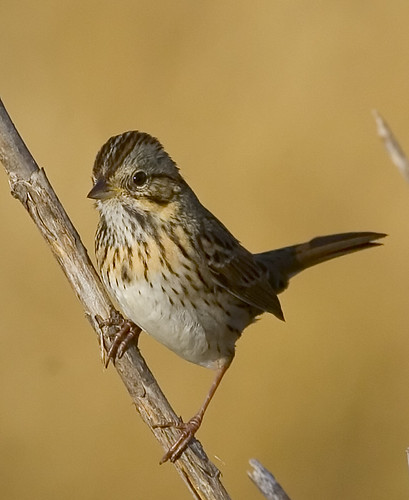tags: Lincoln's Sparrow, Melospiza lincolnii, birds, mystery bird, bird ID quiz
[Mystery bird] Lincoln's Sparrow, Melospiza lincolnii, photographed in Manhattan, Kansas. [I will identify this bird for you tomorrow]
Please name at least one field mark that supports your identification.
Rick Wright, Managing Director of WINGS Birding Tours Worldwide, writes:
Take a good look at this bird: have you ever seen anything more beautiful? "Sparrows" are dismissed by too many birders as difficult and dull, when in fact they are neither.
Well, there are a couple of moderate identification problems -- certain of the sharp-tailed sparrows, or juvenile Aimophila -- but otherwise, given a little bit of experience and a little bit of patience (each leads to the other, you know), most sparrows, even fleetingly glimpsed, are readily identifiable, and all sparrows, well seen, are terrifically beautiful.
The very best introduction to sparrow identification (and to so many other interesting groups) is Kenn Kaufman's Advanced Birding. The title of that handy little volume has put off too many birders, but as the author explains, this is not a book for "advanced" birders, but a book for birders who want to advance their birding -- for all of us, in other words. With clear and simple illustrations, and clear and simple words, Advanced Birding sets forth a "generic approach" to sparrow identification that allows even new birders to quickly reduce the possibilities from an overwhelming 40 or more to just a handful of species.
The bird in the mystery photo is medium-sized (that's not a twig it's perched on), long-tailed, solid-bodied, big-eyed, and medium-billed. This is a Melospiza, what I like to call a "shade sparrow," a member of a genus that prefers wet thickets, cattail edges, and brushpiles.
Once we've got that far, a view like this makes the identification easy. With a perched Melospiza, the easiest thing to look at is the malar, that narrow strip of feathers extending back from the base of the bill along the top of the neck. On Song Sparrow, the malar is white; on Swamp Sparrow, it is gray; and on Lincoln's Sparrow, it is tinged a beautiful yellowish, as on our quiz bird.
Is this a Lincoln's Sparrow? The crown is rusty, finely streaked black, with a broad but well-defined gray median stripe; the huge supercilium is gray, and the narrow eyering is white. From this angle we can't accurately judge the thickness of the bill, but it doesn't seem to be especially swollen. The yellow of the malar continues into a breastband, which is marked with fine streaks; those streaks run down the flank, never getting any thicker. The wing coverts are rusty, the inner greater coverts marked with blobby black teardrops. We can just barely see that the uppertail coverts are finely streaked.
Next time you see a sparrow, stop and watch it. You'll find it first of all dazzlingly beautiful -- and if you pay attention to enough of them, you'll find it satisfyingly identifiable.
- Log in to post comments


I'm going to call this a Lincoln's sparrow. Supporting field marks: The "broad gray supercillium", the "crown often peaked", "slender bill", and "buffy eye-ring" (all per Sibley).
I'll ditto Mr. Callender for same marks (though the peaked crown is one I've never looked for) plus one that's more subjective--that particular pencil-fine streaking--and a couple that vary IME: the buffy wash over the upper breast and sides, and the central breast spot, which can be bold or invisible, depending on what the bird is doing with its feathers.
Years ago I was on my knees digging in someone's garden in north Berkeley when a neighbor's familiar cat walked up and handed me a dead Lincoln's sparrow. Talk about a paralyzed-in-ambivalence moment!
The lesser spotted pied ragamuffin.
Lincoln's sparrow - the dull gold wash across the chest and flanks made the pic jump off the page in Sibley's set of sparrow thumbnails.
Sparrow shape + buffy breast + fine black streaks = lincoln's sparrow
In addition to the marks mentioned above, note the buffy malar stripe.
Lincoln's sparrow. One field mark that I clue into (among others) is the buff colored malar. In Alaska, however, my birder friends clued into the gray area of the face.
This species was the first bird that I banded at a banding class at the Alaska Bird Observatory in Fairbanks. Thanks for the memory. I just wish I could see the LBJ's this clearly in my bins. Heavy sigh.
Lincoln Sparrow.
I think the most notable thing about this photo is that it is much paler than any of the representations in all of my bird books: The Sibley's and Peterson's field guides, Kaufman's life of birds, and the old and new versions (based on art and photos respectively) of Beadle and Risings Sparrows of US.
And even more noteworthy is the great differences between all those images. There must be a great deal of variation in this species!
And isn't that inspiring.
Dear bobk,
The species in question is somewhat variable, but the real issue is that there are so few good images of sparrows of any kind, paintings or photos. If I were writing a field guide (and hm, maybe I am, who knows), I'd have asked this bird to turn just a little to its right, making the image not just breathtakingly beautiful but the perfect one for identification purposes.
National Geographic guide doesn't show a breast spot. I still say Lincoln's.